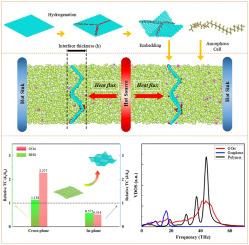石墨烯折纸/石蜡纳米复合材料传热性能的分子动力学研究
IF 7.7
2区 材料科学
Q1 MATERIALS SCIENCE, COMPOSITES
引用次数: 0
摘要
石墨烯/石蜡纳米复合材料具有石墨烯的高导热性和石蜡易于加工的特点,是一种很有前途的电子器件散热热界面材料。近年来,石墨烯基聚合物纳米复合材料的研究主要集中在通过界面工程来改善纳米复合材料的导电性能。作者先前的研究证明,折纸启发的结构修饰不仅提高了石墨烯的柔韧性,而且提高了聚合物纳米复合材料的界面强度。在这项研究中,我们首次使用分子动力学(MD)模拟研究了石墨烯折纸(GOri)增强聚合物基体的传热性能。MD模拟表明,与原始石墨烯填料相比,GOri增强了GOri/聚合物界面的TC,提高了228%。这种显着的TC改善归因于GOri形态提供的填料-基质界面上的强界面相互作用和声子耦合。然而,由于在GOri中存在折痕和sp3 C-H键,纳米复合材料的面内TC降低,因为这些特征增加了声子散射。我们的研究结果表明,GOri是一种高效的聚合物纳米复合材料导热填料,为先进的聚合物基TIMs的设计提供了新的策略。本文章由计算机程序翻译,如有差异,请以英文原文为准。

Investigation on heat transfer performance of graphene origami/paraffin nanocomposites using molecular dynamics
Graphene/paraffin nanocomposites are promising thermal interface materials (TIMs) for heat dissipation in electronic devices with graphene's high thermal conductivity (TC) and paraffin's easy processing. Recent research on graphene-based polymer nanocomposites mainly focuses on TC improvement via interface engineering. Authors' previous studies proved that origami-inspired structural modification not only improves the flexibility of graphene, but also the interfacial strength in polymer nanocomposites. In this research, we report the first study on the heat transfer performance of graphene origami (GOri) reinforced polymer matrix using molecular dynamics (MD) simulations. The MD simulations reveal that GOri enhances the TC at the GOri/polymer interface by 228 % compared to the pristine graphene fillers. This significant TC improvement is attributed to the strong interfacial interactions and phonon coupling at the filler-matrix interfaces provided by the GOri morphology. However, the in-plane TC of the nanocomposites is reduced due to the presence of creases and sp3 C-H bonds in GOri, as these features increase phonon scattering. Our findings indicate that GOri is an efficient thermal conductive filler for polymer nanocomposite and offers new design strategies for advanced polymer-based TIMs.
求助全文
通过发布文献求助,成功后即可免费获取论文全文。
去求助
来源期刊

Composites Communications
Materials Science-Ceramics and Composites
CiteScore
12.10
自引率
10.00%
发文量
340
审稿时长
36 days
期刊介绍:
Composites Communications (Compos. Commun.) is a peer-reviewed journal publishing short communications and letters on the latest advances in composites science and technology. With a rapid review and publication process, its goal is to disseminate new knowledge promptly within the composites community. The journal welcomes manuscripts presenting creative concepts and new findings in design, state-of-the-art approaches in processing, synthesis, characterization, and mechanics modeling. In addition to traditional fiber-/particulate-reinforced engineering composites, it encourages submissions on composites with exceptional physical, mechanical, and fracture properties, as well as those with unique functions and significant application potential. This includes biomimetic and bio-inspired composites for biomedical applications, functional nano-composites for thermal management and energy applications, and composites designed for extreme service environments.
 求助内容:
求助内容: 应助结果提醒方式:
应助结果提醒方式:


